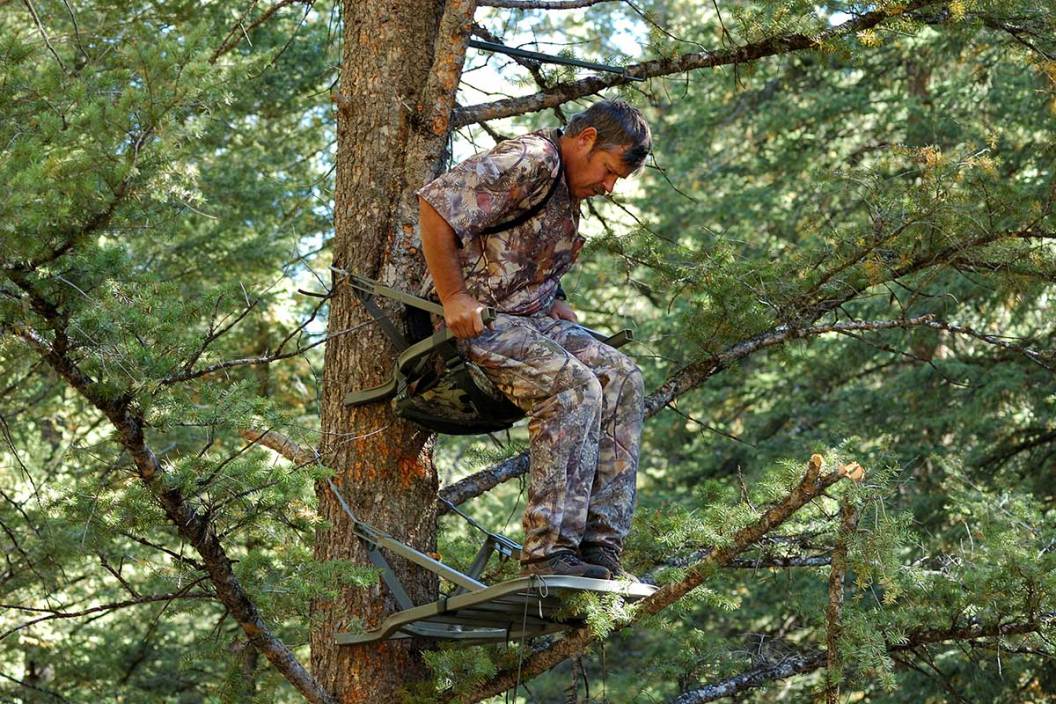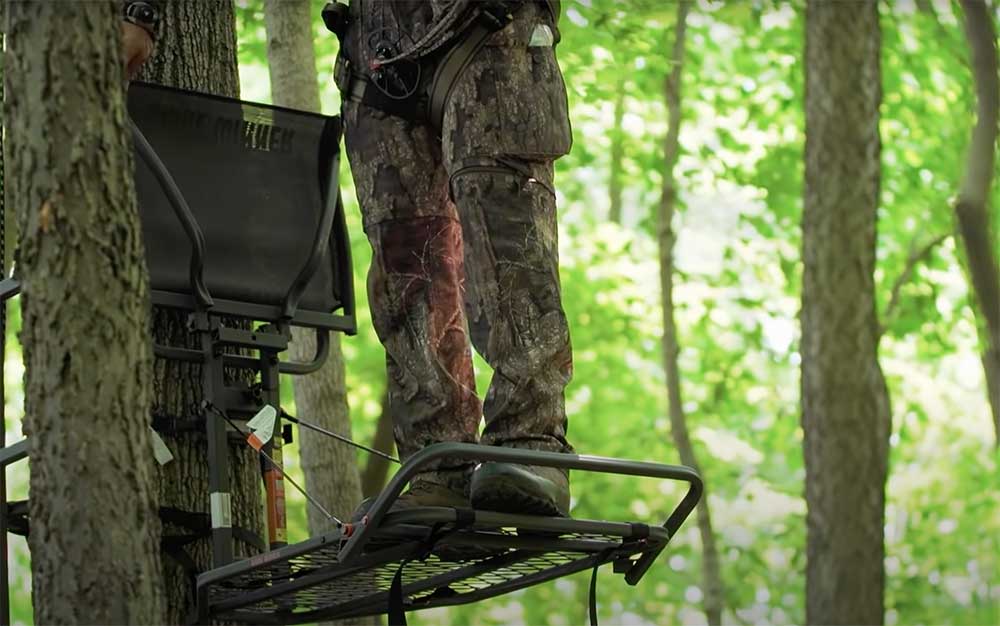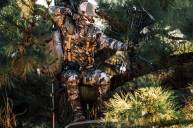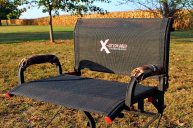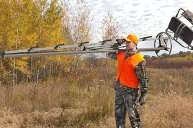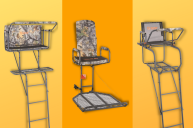Today's whitetail deer hunter knows the importance of staying mobile while hunting. Years ago, before I was wise to the idea of mobile hunting, I got real tired of watching deer walk by out of range. I always sat there wishing I could quickly and efficiently set up in a different location. I'm not saying that ladder stands are completely worthless, but due to their stationary limits, it sure looks like we are headed in that direction. And that's for the better, if you ask me.
Whitetail deer can be extremely unpredictable animals at times. Regardless of how efficient your scouting was, when you're finally in the stand, your target buck can still leave you scratching your head, wondering why he took a trail 60 yards parallel from the one he has been taking for the past three months. This is the time when being mobile is key.
As a source of info and strategy ideas, I'll go through the different types of mobile treestands, and share a few thoughts on each so you can determine what's best for you and your style of hunting.
Mobile Treestand Options
When it comes to the options we as hunters have for staying mobile, there are three main types of treestands that fit the bill: saddle, hang-ons, or climbers. All three have their advantages depending on the situation as well as your preference. They all require different setups and takedown procedures, different levels of comfortability, and different pack-in weights.
Having used all three of these stand types several times over the past few years, I have found that it's a great option to have all of them. Situations arise during the season where you may want to have the ability to switch your setup. While the initial costs may seem steep, there are several inexpensive models on the market for all three types, and with good care, they should last you upwards of 10 seasons with little upkeep.
Tree Saddle
There has been a trend in saddle-style hunting within the past few years, and it's easy to see why. They're fairly easy to set up, they weigh next to nothing, and they provide a level of versatility that is hard to get with any other form of stand.
Weight: One of the most attractive parts about using a tree saddle is how light they are. Hauling in a metal treestand to your hunting spot can not only be noisy, but it can also be exhausting, causing you to sweat. If you've ever hunted in frigid temperatures, you know that moisture is the devil. Most saddles weigh in at less than five pounds, which is about half the weight of even the lightest hang-on stands.
Versatility: The versatility of saddles can best be depicted by sharing characteristics of the other types first. With climbers, and even most hang-on stands, it's imperative that you find a tree that meets a lot of qualifications. It needs to be very straight, not have many limbs towards the bottom, and (especially with climbers) it needs to have the right diameter to work. We all know how difficult it can be to find the right tree. This issue seems to become increasingly important when it is pitch black out, like when you're packing in for a morning hunt.
With tree saddles, you have the versatility to essentially pick any healthy tree and have a solid set up. Not only do you have the versatility of flexible tree selections, but you also gain a near 360-degree view with a saddle. With a climber or hang-on, you're generally stuck facing the direction that your stand is set up for. This can create issues when a cruiser buck seemingly comes out of nowhere and is only in bow range for a few seconds.
Comfort: To an extent, the amount of comfort you get from a tree saddle is up to you. You can choose to stand on your platform, lean up against the tree, or even sit down on the saddle. While the flexibility of this definitely adds a comfort factor, I personally have found that tree saddles leave a little to be desired for those all day sits.
Hang-On Stands
Hang-on stands are still the preferred choice by a large number of hunters. It's hard to beat the comfort level and the ease of use. There is also a safety mindset about them that I just don't think saddles have acquired quite yet, at least until enough people have experienced saddle hunting. Sometimes called a "lock-on stand," this type does involve a little more work to get set up, but can pay dividends.
Weight: Of the three types of mobile treestands, hang-ons tend to be the heaviest when you include the climbing sticks. Most sets weigh in between 18 and 20 pounds, which is relatively heavy compared to a saddle and a climber. While I don't think the added weight is something that should deter hunters from using this method, it's definitely a factor that comes into play.
Versatility: The versatility you get with a hang-on stand drives a lot of hunters to make the switch. With some practice, you can easily set up in your desired tree in under 10 minutes, and you don't need to be too picky on which tree you set up in.
Using a "Hang-n-Hunt" method is what has led me to harvest three of my last four bucks. Almost every one of those occasions involved me hunting in one spot, noticing that the deer were traveling on a different path, and setting up a hang-on stand there the next day. While you can still do this with a saddle and even a climber, I have found that it's much simpler with a hang-on.
Comfort: During the rut, or even for most of the month of November, spending hours in the stand is what separates successful seasons from unsuccessful ones. All day sits are crucial. Sitting in one spot for 12+ hours can be miserable without the right stand, and I personally haven't found a more comfortable option than using a hang-on.
Climbing Stands
There's a simplicity to leaving the climbing sticks at home and throwing a climber on your back as you head into the woods. The setup is easy, and generally speaking, most climbers fold down into packs that are very light and easy to hike in with. On days where I am in a rush, or maybe just don't feel like taking the time to hang a stand, using a climber is my go-to.
Weight: The weight of most climbers typically falls just under that of a hang-on set. Most treestand manufacturers now have models weighing in at less than 15 pounds, which isn't too exhausting, especially considering how conveniently they fold up for easy transportation.
Versatility: One of the major downfalls about using a climber is the lack of trees that you are able to climb with it. I prefer to look for trees that I know work well with climbers. My two favorites to climb are oaks and maples. The lack of low branches, and the soft bark makes it easy to securely latch on, while also providing ample cover, at least by climber standards. Ultimately, the ease of use makes up for the lack of versatility as far as tree selection goes.
Comfort: Climbers share a similar comfort to that of hang-ons, however there is one drawback. They don't feel quite as sturdy, as they are usually latched on by a rubber tube that uses the weight of the hunter to keep it secured. Because of this, constant adjusting and movements can seem unstable. I have yet to do an all day sit in my climber, and I'm not sure that will ever change.
Your Stand, Your Choice
There's no real clear winner in the so-called debate about treestand preference. It will ultimately come down to what works best for your specific situation. I know several hunters who only use climbers. I have a friend that switched to a saddle two years ago and he hasn't looked back since. I still fall under the umbrella of hunters who feel there is room for all three in a hunting strategy. I enjoy deciding which of my three I will take out, depending on what the hunt calls for. Having options is important. Staying mobile is even more important.
